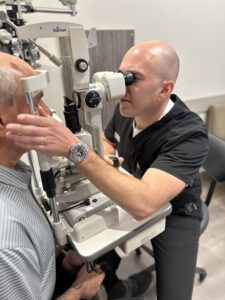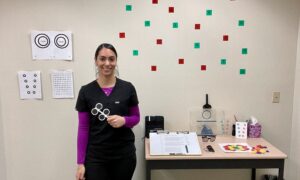
Dr. Moscow examines a patient. Dr. Moscow says that proper coding for Meibomian Gland Dysfunction & Keratoconjunctivitis Sicca is essential for patients and for the doctor getting paid.
By Scott R. Moscow, OD
May 10, 2023
Dry eye disease is becoming more prevalent with our aging population and the side effects of many commonly prescribed medications. Some 44 million people experience dry eye symptoms in the U.S., according to Market Scope’s 2020 Dry Eye Products Market Report.1 Here is how to code for two diagnoses related to dry eye, Meibomian Gland Dysfunction and Keratoconjunctivitis Sicca.
Avoid Coding “Unspecified”
It is the doctor’s job to determine eye, stage, etc. Never use a code with the specific term “Unspecified” because you will likely not get paid. However, a code with terms such as “Not Specified” will most likely get paid if billed correctly.
Keep in Mind the “Global Period”
This is the period of time starting with a surgical procedure and ending some period of time after the procedure where all exams associated with the surgical procedure are covered by a global fee.
68761 “Closure of the lacrimal punctum; by plug, each” has a 10 Day Global Period
Note: Procedures and Diagnostics testing are billable during a global period. The global period just applies to Exams (992xx or 920xx).
Minor Surgical Procedures Rules
It may or may not be appropriate for you to bill for an exam (992xx or 920xx) on the same date of service as a minor surgical procedure.
“In general, E&M services on the same date of service as the minor surgical procedure are included in the payment for the procedure. The decision to perform a minor surgical procedure is included in the payment for the minor surgical procedure and shall not be reported separately as an E&M service.” In other words, any evaluation that was done to determine the need for the surgical procedure is included in that surgical procedure. If you ONLY did a surgical procedure, it is NOT appropriate to bill for an exam (992xx or 920xx).
“A significant and separately identifiable E&M service unrelated to the decision to perform the minor surgical procedure is separately reportable with modifier 25.” In other words, in order to justify an exam (992xx or 920xx) on the same date of service as a surgical procedure, you must be evaluating something significant and separately identifiable from the surgical procedure.
Multiple Surgical Procedures in the Same Day
If more than one punctal plugs is inserted on the same day, there is a decrease in reimbursement for the 2nd, 3rd and 4th plug(s)
- 1st Plug = 100% of insurance allowable
- 2nd plug = 50% of insurance allowable
- 3rd plug = 25% of insurance allowable
- 4th plugs = 25% of insurance allowable
Modifiers
Use These Codes
H02.881 Meibomian Gland Dysfunction Right Upper Eyelid
H02.882 Meibomian Gland Dysfunction Right Lower Eyelid
H02.884 Meibomian Gland Dysfunction Left Upper Eyelid
H02.885 Meibomian Gland Dysfunction Left Lower Eyelid
H02.88A Meibomian Gland Dysfunction Right Eye, Upper and Lower Eyelids
H02.88B Meibomian Gland Dysfunction Left Eye, Upper and Lower Eyelids
H16.221 Keratoconjunctivitis Sicca, Not Specified as Sjogren’s, Right Eye
H16.222 Keratoconjunctivitis Sicca, Not Specified as Sjogren’s, Left Eye
H16.223 Keratoconjunctivitis Sicca, Not Specified as Sjogren’s, Bilateral
-25 Modifier
- “Significant, Separately Identifiable Evaluation and Management Service by the Same Physician or Other Qualified Health Care Professional on the Same Day of the Procedure or Other Service”
- This modifier is attached to the Exam (992xx or 920xx)
- Exam’s Primary Chief Complaint and History of Present Illness (HPIs) should show you are evaluating something significant and separately identifiable from the surgical procedure (if accurate and appropriate)
Note: This is a red flag for audits. When you use the -25 modifier, make sure it’s appropriate and document properly.
-GA Modifier
- If you have reason to believe an insurance company will not pay for a particular service (such as an in-office meibomian gland heating treatment), have the patient sign a Waiver of Liability (also known as Advanced Beneficiary Notice, or ABN, specifically for Medicare).
- Some insurance companies, such as Tricare, require you to use their specific Waiver of Liability.
- If the Waiver of Liability (or Advanced Beneficiary Notice) is signed, and the claim is denied, the patient will be fully and personally liable to pay you for the service.
- If a waiver is signed, add the -GA modifier to the claim.
- The -GA modifier will not influence determination of coverage.
Note: Even with the -GA modifier, if the procedure is paid for by the insurance company, you can NOT bill the patient the difference between the insurance allowable and your usual and customary charges.
Lid Modifiers
- -E1 = Upper Left, eyelid
- -E2 = Lower Left, eyelid
- -E3 = Upper Right, eyelid
- -E4 = Lower Right, eyelid
- -RT = Right side (used to identify procedures performed on the right side of the body)
- -LT = Left side (used to identify procedures performed on the left side of the body)
Tip: For Eyelid procedures, it’s technically most accurate to use –E1, -E2, -E3 and/or –E4. However, some insurance carriers only accept -RT and/or -LT. I find myself using -RT/-LT if only one procedure is performed or if only one procedure is performed on the right side and only one procedure is performed on the left side.
Case Study
Exam for Treatment for Meibomian Gland Dysfunction & Keratoconjunctivitis Sicca treated with Punctal Plugs
At a patient’s exam (992xx or 920xx) for meibomian gland dysfunction on all lids in both eyes, you note improvement with eyelid scrubs, hot compresses and the omega 3 vitamins that the patient had previously started. You also decide to perform TearCare (an in-office meibomian gland heating and evacuation treatment with manual expression) on all four eyelids.
Other Articles to Explore
For the patient’s Keratoconjunctivitis Sicca, you continue Cyclosporin 0.05% BID OU and decide to insert surface mount plugs into the Lower Right and Lower Left Punctum that day.
Chief Complaint: Existing Condition, Meibomian Gland Dysfunction
History of Present Illness (HPI’s)
- Location: Right Eye (Upper and Lower Eyelids) & Left Eye (Upper and Lower Eyelids)
- Quality: Improving
- Severity: Moderate
- Duration: 1 month
- Timing: Constant
- Context: All the time
- Modifying Factors: Scrubs, Hot Compresses, Omega 3 Vitamins & PFAT
- Signs/Symptoms: Ocular Irritation
Note: Cyclosporin is being used to treat Keratoconjunctivitis Sicca (NOT Meibomian Gland Dysfunction) therefore it should not be listed in the modifying factors for Meibomian Gland Dysfunction.
Assessment & Plan
- Assessment 1. H02.88A Meibomian Gland Dysfunction Right Eye, Upper and Lower Eyelids
- Plan: Continue Scrubs, Hot Compresses, Omega 3 Vitamin, PFAT & TearCare performed today.
- Assessment 2. H02.88B Meibomian Gland Dysfunction Left Eye, Upper and Lower Eyelids
- Plan: Continue Scrubs, Hot Compresses, Omega 3 Vitamin, PFAT & TearCare performed today.
- Assessment 3. H16.223 Keratoconjunctivitis, Sicca
- Plan: Continue Cyclosporin 0.05% BID OU. Inserted Surface Mount Punctal Plugs into Lower Right and Lower Left Puncta. All other treatments, including trial period of artificial tears, proved unsuccessful in relieving the patient’s symptoms before utilization of plugs.
Note: TearCare is an in-office procedure used for the evacuation of meibomian glands, using heat delivered through wearable, open-eye eyelid treatment devices and manual gland expression.
Coding
- Exam Code-25
- Associated Diagnosis: H02.88A Meibomian Gland Dysfunction Right Eye, Upper and Lower Eyelids
- 0563T-GA (Evacuation of meibomian glands, using heat delivered through wearable, open-eye eyelid treatment devices and manual gland expression, bilateral)
- Associated Diagnosis: H02.88A Meibomian Gland Dysfunction Right Eye, Upper and Lower Eyelids
- 68761-RT (Closure of the lacrimal punctum; by plug, each)
- Associated Diagnosis: H16.223 Keratoconjunctivitis, Sicca
- 68761-LT (Closure of the lacrimal punctum; by plug, each)
- Associated Diagnosis: H16.223 Keratoconjunctivitis, Sicca
Note: Since I do not expect the insurance company to pay for 0563T (TearCare), I had the patient sign a waiver and added the -GA modifier to the procedure.
References
1. Market Scope, 2020 Dry Eye Products Market Report, page 34
 Scott R. Moscow, OD, is the Clinical Director of Roswell Eye Clinic in Roswell, Ga. To contact him: scott@roswelleyeclinic.com
Scott R. Moscow, OD, is the Clinical Director of Roswell Eye Clinic in Roswell, Ga. To contact him: scott@roswelleyeclinic.com



























